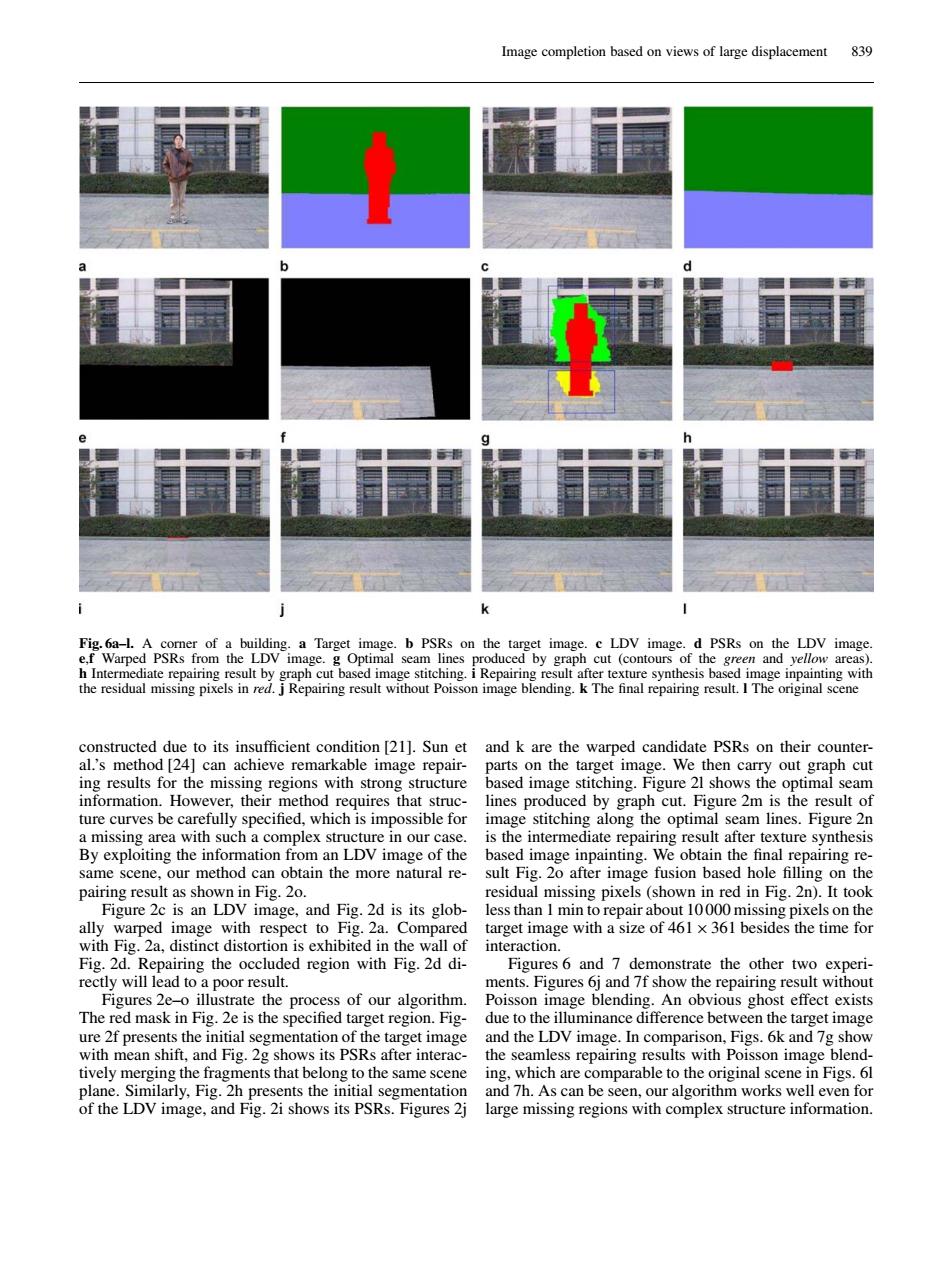正在加载图片...

Image completion based on views of large displacement 839 j k Fig.6a-1.A corner of a building.a Target image.b PSRs on the target image.c LDV image.d PSRs on the LDV image. e.f Warped PSRs from the LDV image.g Optimal seam lines produced by graph cut (contours of the green and vellow areas). h Intermediate repairing result by graph cut based image stitching.i Repairing result after texture synthesis based image inpainting with the residual missing pixels in red.j Repairing result without Poisson image blending.k The final repairing result.I The original scene constructed due to its insufficient condition [21].Sun et and k are the warped candidate PSRs on their counter- al.'s method [24]can achieve remarkable image repair- parts on the target image.We then carry out graph cut ing results for the missing regions with strong structure based image stitching.Figure 21 shows the optimal seam information.However,their method requires that struc-lines produced by graph cut.Figure 2m is the result of ture curves be carefully specified,which is impossible for image stitching along the optimal seam lines.Figure 2n a missing area with such a complex structure in our case.is the intermediate repairing result after texture synthesis By exploiting the information from an LDV image of the based image inpainting.We obtain the final repairing re- same scene,our method can obtain the more natural re- sult Fig.20 after image fusion based hole filling on the pairing result as shown in Fig.20. residual missing pixels (shown in red in Fig.2n).It took Figure 2c is an LDV image,and Fig.2d is its glob- less than I min to repair about 10000 missing pixels on the ally warped image with respect to Fig.2a.Compared target image with a size of 461 x 361 besides the time for with Fig.2a,distinct distortion is exhibited in the wall of interaction. Fig.2d.Repairing the occluded region with Fig.2d di- Figures 6 and 7 demonstrate the other two experi- rectly will lead to a poor result. ments.Figures 6j and 7f show the repairing result without Figures 2e-o illustrate the process of our algorithm. Poisson image blending.An obvious ghost effect exists The red mask in Fig.2e is the specified target region.Fig- due to the illuminance difference between the target image ure 2f presents the initial segmentation of the target image and the LDV image.In comparison,Figs.6k and 7g show with mean shift,and Fig.2g shows its PSRs after interac-the seamless repairing results with Poisson image blend- tively merging the fragments that belong to the same scene ing,which are comparable to the original scene in Figs.61 plane.Similarly,Fig.2h presents the initial segmentation and 7h.As can be seen,our algorithm works well even for of the LDV image,and Fig.2i shows its PSRs.Figures 2j large missing regions with complex structure information.Image completion based on views of large displacement 839 Fig. 6a–l. A corner of a building. a Target image. b PSRs on the target image. c LDV image. d PSRs on the LDV image. e,f Warped PSRs from the LDV image. g Optimal seam lines produced by graph cut (contours of the green and yellow areas). h Intermediate repairing result by graph cut based image stitching. i Repairing result after texture synthesis based image inpainting with the residual missing pixels in red. j Repairing result without Poisson image blending. k The final repairing result. l The original scene constructed due to its insufficient condition [21]. Sun et al.’s method [24] can achieve remarkable image repairing results for the missing regions with strong structure information. However, their method requires that structure curves be carefully specified, which is impossible for a missing area with such a complex structure in our case. By exploiting the information from an LDV image of the same scene, our method can obtain the more natural repairing result as shown in Fig. 2o. Figure 2c is an LDV image, and Fig. 2d is its globally warped image with respect to Fig. 2a. Compared with Fig. 2a, distinct distortion is exhibited in the wall of Fig. 2d. Repairing the occluded region with Fig. 2d directly will lead to a poor result. Figures 2e–o illustrate the process of our algorithm. The red mask in Fig. 2e is the specified target region. Figure 2f presents the initial segmentation of the target image with mean shift, and Fig. 2g shows its PSRs after interactively merging the fragments that belong to the same scene plane. Similarly, Fig. 2h presents the initial segmentation of the LDV image, and Fig. 2i shows its PSRs. Figures 2j and k are the warped candidate PSRs on their counterparts on the target image. We then carry out graph cut based image stitching. Figure 2l shows the optimal seam lines produced by graph cut. Figure 2m is the result of image stitching along the optimal seam lines. Figure 2n is the intermediate repairing result after texture synthesis based image inpainting. We obtain the final repairing result Fig. 2o after image fusion based hole filling on the residual missing pixels (shown in red in Fig. 2n). It took less than 1 min to repair about 10 000 missing pixels on the target image with a size of 461×361 besides the time for interaction. Figures 6 and 7 demonstrate the other two experiments. Figures 6j and 7f show the repairing result without Poisson image blending. An obvious ghost effect exists due to the illuminance difference between the target image and the LDV image. In comparison, Figs. 6k and 7g show the seamless repairing results with Poisson image blending, which are comparable to the original scene in Figs. 6l and 7h. As can be seen, our algorithm works well even for large missing regions with complex structure information